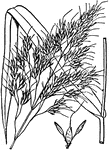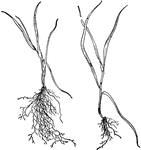The Grasses and Grains ClipArt gallery offers 423 illustrations of various types of grasses and grains, many of which are grown agriculturally for consumer use.
All illustrations in the ClipArt ETC collection are line drawings. If you are looking for color photographs of grasses, please visit the ClipPix ETC website.
Timothy Grass
Timothy is commonly grown for cattle feed and, in particular, as hay for horses. It is relatively high…

Timothy Grass
Timothy (Phleum pratense), or Herd's Grass is commonly grown for cattle feed and, in particular, as…
Timothy Grass
Timothy Grass is commonly grown for cattle feed and, in particular, as hay for horses. It is relatively…
Timothy Grass
Timothy Grass is commonly grown for cattle feed and, in particular, as hay for horses. It is relatively…
Timothy Grass
Timothy Grass is commonly grown for cattle feed and, in particular, as hay for horses. It is relatively…
Two-rowed Barley
The Two-rowed Barley's spike, or ear, is long and somewhat compressed, and the grain is of a very good…
Virginia Cut Grass
Virginia Cut Grass (Leersia Virginica) is a small flowered white grass, and is smoother than white grass…

Virginia Cut Grass
Virginia Cut Grass (Leersia Virginica) is a small flowered white grass, and is smoother than white grass…
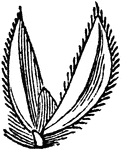
Virginia Cut Grass
Virginia Cut Grass (Leersia Virginica) is a small flowered white grass, and is smoother than white grass…
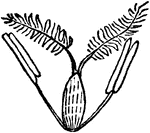
Virginia Cut Grass
Virginia Cut Grass (Leersia Virginica) is a small flowered white grass, and is smoother than white grass…
Virginia Cut Grass
Virginia Cut Grass (Leersia Virginica) is a small flowered white grass, and is smoother than white grass…

Virginia Cut Grass
Indian Rice Grass (Zizania aquatica), also known as Wild Rice, or Water Oats, is found in swampy borders…

Water Hair Grass
Water Hair Grass (Aira aquatica) is the sweetest of the British grasses. Its stems and leaves when green…

Water Spear Grass
Water Spear grass (Glyceria aquatica), also known as Reed Meadow grass, grows in wet soils and the shallow…
Water Spear Grass
Water Spear grass (Glyceria aquatica), also known as Reed Meadow grass, grows in wet soils and the shallow…
Wheat
Egyptian wheat (Sorghum bicolor) has long slender stalks growing seven to ten feet. It matures late…
Wheat
St. Peter's corn (Triticum monococcum) is a one-seeded wheat with a high portein content. This picture…
Wheat
Wheat (Triticum vulgare) is an annual herbaceous plant. The seed is oblong, or a compressed oval, surrounded…
Wheat
Wheat (Triticum vulgare) is an annual herbaceous plant. The seed is oblong, or a compressed oval, surrounded…
Wheat
Wheat (Triticum spelta) is an annual herbaceous plant. The seed is oblong, or a compressed oval, surrounded…
Wheat
Wheat (Triticum spelta) is an annual herbaceous plant. The seed is oblong, or a compressed oval, surrounded…
Wild Oat Grass
Wild Oat Grass (Danthonia spicata), also referred to as White Top grass, and Old Fog grass, is common…

Wild Oat Grass
Wild Oat Grass (Danthonia spicata), also referred to as White Top grass, and Old Fog grass, is common…

Wild Oat Grass
Wild Oat Grass (Danthonia spicata), also referred to as White Top grass, and Old Fog grass, is common…

Wild Oat Grass
Wild Oat Grass (Danthonia spicata), also referred to as White Top grass, and Old Fog grass, is common…
Wild Oat Grass
Wild Oat Grass (Danthonia spicata), also referred to as White Top grass, and Old Fog grass, is common…

Wood Hair Grass
Wood Hair grass (Aira flexuosa), also known as Common Hair grass, is a common grass found on dry and…
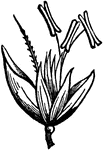
Wood Hair Grass
Wood Hair grass (Aira flexuosa), also known as Common Hair grass, is a common grass found on dry and…

Wood Meadow Grass
Wood Meadow Grass (Poa nemoralis) grows from eighteen inches to two feet high. It has a perennial, creeping…

Wood Meadow Grass
Wood Meadow Grass (Poa nemoralis) grows from eighteen inches to two feet high. It has a perennial, creeping…
Yellow Oat Grass
The Yellow Oat Grass (Avena flavescens) is a perennial grass siutable for dry meadows and pastures.…

Yellow Oat Grass
The Yellow Oat Grass (Avena flavescens) is a perennial grass siutable for dry meadows and pastures.…
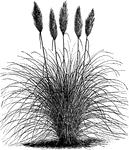
Gynerium Argenteum
The common name of gynerium is pampas grass. Gynerium argenteum grass reaches between six and ten feet…
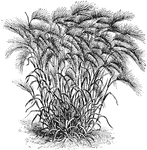
Hordeum Jubatum
The common name of hordeum jubatum is squirrel tail grass. The flowers on this grass bloom in June.…

Indian Millet
This is an illustration of the Indian Millet plant. It is native to Nevada and Utah in the southwestern…

Juncus Acutiflorus
Juncus acutiflorus belongs to a genus of grass-like herbs (Juncus) that grow in boggy places.

Juncus Compressus
Juncus compressus belongs to a genus of grass-like herbs (Juncus) that grow in boggy places.
Juncus Conglomeratus
Juncus conglomeratus, also known as the common rush, belongs to a genus of grass-like herbs (Juncus)…

Juncus Effusus
Known as the soft rush, Juncus effusus is nearly as common as the most common species, J. conglomeratus.…

Juncus Glaucus
Juncus glaucus belongs to a genus of grass-like herbs (Juncus) that grow in boggy places.

Juncus Squamosus
Juncus squamosus belongs to a genus of grass-like herbs (Juncus) that grow in boggy places.

Lagurus Ovatus
Lagurus ovatus is an attractive grass with soft white, woolly heads. The heads are one to two inches…

Lamarckia Aurea
Lamarckia aurea is a handsome grass with oblong feathery, golden-yellow flower clusters. The common…
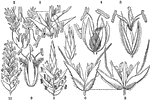
Grass Locusta
"1. Locusta of Corynephorus canescens (Grey Hair-grass); 2. paleae, &c. of the same; 3. locusta of Phalaris…

Yellow Lyme Grass
"Yellow lyme grass (Elymus flavescens): a, empty glumes; b, spikelet, empty glumes removed." -Department…

Millet
A grass extensively cultivated in some sections of the United States for forage. There are numerous…

Ankee Millet
"'Ankee' Millet: a and b, two views of the spikelet; c and d, two views of the 'seed.'" -Department…

Broom-Corn Millet
"Broom-corn Millet: a, b, and c, views of the spikelet and glumes, or chaff; d and e, two views of the…

German Millet
"German Millet: a and b, two views of the spikelet with its cluster of three "beards;" c, 'seed.'" -Department…

Shama Millet
"Shama Millet: a, b, c, d, different views of the spikelet and glumes, or chaff; e, f, two views of…

Miscanthus Sinensis
Miscanthus sinensis is a tall, perennial grass. Established plants form clumps as much as eighteen feet…

Miscanthus Sinensis Varieties
Illustrated are varieties of miscanthus sinensis in cultivation, from left to right: variegatus, zebrinus,…

